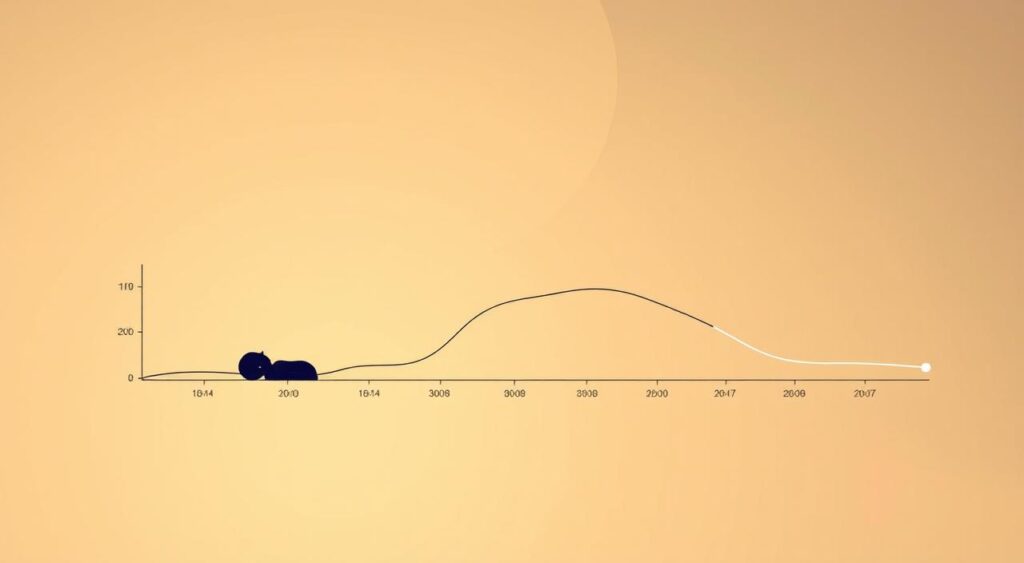Have you ever wondered if eating earlier in the day could sharpen your sleep, mood, and metabolism?
Circadian fasting is a way to eat that matches your body’s natural rhythm. It means eating only in the early hours of the day. This method focuses on when you eat, not how much.
Experts suggest eating within a 6 to 12 hour window. For example, from 8 a.m. to 6 p.m. This creates a 14-hour fast overnight. But, there’s no one-size-fits-all schedule for everyone.
This guide will show you how to start circadian fasting. It helps you align meals with your body’s natural cycles. It aims to boost your metabolism and sleep quality. It’s for readers in the United States. Always talk to a healthcare professional before starting if you have health concerns.
What is Circadian Fasting?

Circadian rhythm fasting means eating only during daylight hours. This approach is similar to time-restricted eating but focuses on an earlier eating window. It matches with natural light–dark cycles. You might eat from 8 a.m.–6 p.m. or 10 a.m.–6 p.m.
This method is important because it changes when you eat, not just what. Unlike some fasting plans that allow late-night meals, it encourages eating during the day. This helps align with your body’s natural rhythm.
Understanding the Concept
Circadian fasting links meals with light and activity. Eating during the day tells your body to work better. This can improve digestion and how your body uses energy.
This idea combines chronobiology and nutrition, known as chrononutrition. It aims to improve fasting and metabolism by timing food with your internal clock.
The Science Behind It
Your body has a master clock in the hypothalamus. Light and meal times send signals to your body’s clocks. These clocks control genes that change throughout the day.
Hormones play a big role in circadian fasting. Melatonin goes up at night, and cortisol in the morning. Insulin sensitivity is better in the afternoon. Body temperature is lowest at 4 a.m. and highest at 6 p.m.
These rhythms affect how your body digests food and uses energy. Circadian fasting can change these rhythms. It can also change how your body uses energy and what it prefers at different times.
| Aspect | Typical Timing | Metabolic Relevance |
|---|---|---|
| Melatonin | Peaks midnight–3 a.m. | Signals night, reduces digestive readiness |
| Cortisol | Peaks ~7–8 a.m. | Boosts morning alertness and energy mobilization |
| Insulin sensitivity | Higher in afternoon (~5 p.m.) | Improves glucose handling with daytime meals |
| Body temperature | Lowest ~4 a.m.; highest ~6 p.m. | Reflects metabolic rate and performance window |
| Recommended eating window | 8–12 hours, up to 16 hours fast | Aligns time-restricted eating with circadian cues |
Benefits of Circadian Fasting
Aligning your meals with daylight can change how you feel each day. Circadian fasting benefits go beyond weight loss. They touch sleep, blood sugar, metabolism, and mental clarity. It asks you to eat when your body is active and fast overnight for repair.

Improved Sleep Quality
Eating earlier in the evening cuts down on late-night calories that can disrupt sleep. Finishing meals before bedtime lets melatonin work better. This helps you fall asleep faster and wake up feeling rested.
Consistent sleep schedules make these fasting benefits more reliable. They help your body get into a better rhythm at night.
Enhanced Weight Management
Time-restricted eating can reduce calorie intake by about one-fifth without dieting. This can help with weight loss while keeping hunger in check.
Eating most of your calories in the day links to lower BMI. You might snack less in the evening and have fewer cravings. This happens when your eating window matches your active hours.
Better Blood Sugar Control
Eating mostly during daylight hours helps keep glucose levels steady. Early time-restricted eating has been linked to lower fasting insulin and reduced insulin resistance in studies.
This alignment can mean steadier blood sugar levels throughout the day. For those with metabolic concerns, it improves glucose regulation and lowers average daily glucose.
Boosted Mental Clarity
Syncing feeding with your body clock may sharpen focus indirectly. Better sleep, lower inflammation, and steadier energy metabolism support cognitive function over time.
Human evidence is growing, but early studies and animal work suggest clearer thinking. You might notice improved concentration as fasting and energy levels stabilize during your active hours.
Additional metabolic benefits
- Lower blood pressure and improved cholesterol balance.
- Reduced inflammatory markers such as hsCRP with fewer night calories.
- Shifts in lipid metabolism and peripheral clock genes that help fasting and metabolism adapt to your routine.
How to Get Started with Circadian Fasting
Starting circadian fasting is about making small, steady changes. Choose a simple fasting schedule and aim for daily consistency. This approach makes it easier to adapt and helps your body adjust to new hunger and energy patterns.

Setting Your Eating Window
Start with a fasting window that fits your life. Many begin with a 10–12 hour eating window, like 8 a.m.–6 p.m. Then, they adjust to 10 a.m.–6 p.m. or 10 a.m.–8 p.m. The goal is to keep the fasting window the same each day to help your body adjust.
Plan your first meal soon after waking or after a short morning activity. Use water or noncaloric drinks during fasting hours to stay hydrated. When you’re ready, gradually adjust your eating times by 30–60 minutes every few days.
Choosing Your Meal Times Wisely
Put most of your calories in the morning to match your body’s metabolic readiness. Have a hearty breakfast and an early lunch. Keep dinner within your fasting schedule. Avoid eating late at night, as your body’s glucose tolerance may worsen after melatonin rises.
Adjust your plan to fit your chronotype, work hours, and family life. For guidance, check out intermittent fasting guides that offer tips on timing and food choices.
- Start with a 10–12 hour eating window; tighten slowly if desired.
- Front-load calories: larger breakfast, moderate lunch, light early dinner.
- Keep a firm end time for dinner and sip water during the fasting window.
- Adjust for seasons and schedule; you don’t need to follow sunrise exactly.
If you’re older, underweight, pregnant, breastfeeding, or have a history of eating disorders, consult a healthcare professional before starting. Tailoring your fasting schedule to your needs ensures a healthier start to circadian fasting.
Aligning Your Meals with Your Body Clock
Meals at the right time make you feel more alert and balanced. Your body’s internal clock tells you when to be awake and when to sleep. It also shows when you digest food best. Small changes in timing can make a big difference in how you feel.

Understanding Your Internal Timing
Your chronotype is important. Early birds feel most alert and insulin sensitive in the morning. Night owls feel it later. Light, sleep, and meal times all influence your body’s clock.
Hormones send clear signals. Cortisol wakes you up in the morning. Melatonin helps you sleep at night. Your body temperature and insulin responses also follow a daily rhythm. Eating when your body is ready makes digestion smoother.
Listening to Your Body’s Hunger Cues
Listen to real hunger, not just snacking. True hunger grows slowly and is satisfied by balanced food. Cravings for late-night snacks are often not true hunger.
Check in with your body throughout the day. Notice how hunger and energy change after sleep, light, and exercise. Time-restricted eating can naturally reduce hunger, making it easier to stick to your routine.
Simple routines help align your body’s signals. Keep regular wake and sleep times. Get morning light and exercise during the day. Eat main meals when your body is most ready, like in the morning and late afternoon. These habits support your body’s natural fasting and energy management.
Common Myths About Circadian Fasting
Before starting a time-based eating plan, it’s important to know the truth. Many myths make circadian fasting seem too hard or magical. Getting the right information helps you set a realistic fasting schedule and avoid stress.
Dispel the Myths
Some think you must fast all day to see benefits. But, circadian fasting is about eating windows, not full-day fasting. Research shows eating earlier can help you stay within a normal calorie range without feeling too hungry.
Another myth is that late-night snacks are okay. But, eating after 8 p.m. can lead to poor glucose control and higher BMI. This shows how timing matters in fasting.
Many believe circadian fasting is a magic solution for everyone. But, it works differently for each person, based on age, weight, and health. It’s important to listen to how your body reacts. For tips on aligning your eating with daylight, check out this guide at circadian fasting facts.
Understanding Your Body’s Needs
If you’re older, underweight, or have a history of eating disorders, you might need a different plan. It’s key to ensure you get enough nutrients and follow the USDA Dietary Guidelines when adjusting your meal times.
Fasting and metabolism work differently for everyone. While studies offer insights, they might not apply to you. Be cautious when comparing myths to your own experiences.
Exercising on an empty stomach can help burn fat instead of carbs. But, everyone’s energy needs and recovery are unique. Pay attention to hunger, sleep, and how you feel as you try a new fasting schedule.
Tips for Successful Circadian Fasting
Start with simple rules that fit your day. Use practical tools to build consistency and protect your energy. Small changes to meal timing, hydration, and prep make time-restricted eating easier to sustain.
Meal Prep and Planning
Plan nutrient-dense breakfasts and lunches so you get most calories early in the eating window. Prioritize vegetables, fruits, whole grains, lean proteins, and healthy fats following USDA guidance.
Batch cook proteins like chicken breast or salmon and prepare grains such as quinoa. Pack ready-to-go breakfasts like overnight oats, eggs, or Greek yogurt with fruit to avoid late-day snacking.
Set alarms for your eating start and stop times. This fasting window planning helps you stay on track and makes meal prep for fasting less stressful.
Staying Hydrated
Drink water throughout fasting hours to support energy and curb false hunger cues. Black coffee and unsweetened tea are fine during the fast and can ease appetite dips.
Avoid sugary drinks and alcohol inside or outside the eating window. Good fasting and hydration habits reduce cravings and help you focus on nutrient quality when you eat.
Pair your schedule with regular activity per CDC recommendations. Use time-restricted eating tips like consistent wake and sleep times to sync meals with your body clock.
Making Adjustments for Your Lifestyle
Adapting to a busy life with circadian fasting is all about small steps. Start by picking an eating window that fits your daily routines. Try to eat most of your calories in the morning, but stay flexible to keep the plan working.
Adapting to Work
If you work during the day, start eating in the morning and finish early. For those with night shifts, focus on keeping a consistent eating schedule, not strict hours.
When you have to eat late, try to avoid eating when your body’s melatonin is high. If you can’t, eat light and keep your meals regular. If your work hours are really unusual, talk to a doctor for a personalized plan.
Traveling Tips
Traveling across time zones can mess with your body clock. Try to eat at local daylight hours and get morning light to reset your body. For short trips, stay hydrated and try to stick to your usual eating times.
Before a long trip, slowly adjust your eating window over a few days. This helps your body adjust to new times faster and reduces jet lag.
Practical Fasting Window Adjustments
Adjust your fasting window as needed to stay consistent. You don’t have to change it with every season. Pick a window that works for you and keeps most of your eating in the morning.
If you need ideas, check out this intermittent fasting meal plan for inspiration. You can adjust it to fit your schedule.
| Situation | Recommended Action | Why It Helps |
|---|---|---|
| Daytime job | Start eating at breakfast, finish by early evening | Matches daylight, supports sleep and metabolism |
| Night shift | Maintain consistent meal timing; keep night snacks light | Reduces circadian misalignment and digestive strain |
| Crossing time zones | Shift meals toward local daytime before arrival | Speeds circadian reset and lessens jet lag |
| Short trips | Approximate your home eating window; drink water frequently | Minimizes disruption to routines and hunger cues |
| Seasonal daylight changes | Keep window length steady; move start time slightly earlier if helpful | Maintains habit without overcorrection |
- Keep a steady routine when possible to simplify fasting and work schedules.
- Use light exposure and meal timing to support travel and time-restricted eating shifts.
- Make gradual fasting window adjustments when needed to avoid stress on your system.
Circadian Fasting vs. Traditional Fasting
Knowing how meal timing affects health is key to picking a good plan. This guide compares fasting methods that impact sleep, metabolism, and energy. It shows the similarities and differences between circadian and intermittent fasting.
Key Differences
Circadian fasting focuses on fasting early in the day. It aligns with daylight and your body’s natural rhythm. This helps with glucose tolerance and keeps your body’s clocks in sync.
Traditional intermittent fasting, like a 16:8 plan, lets you choose your fasting time. Many pick midday to evening for ease, which might not align with your body’s natural rhythm.
Time-restricted eating has different focuses. One aims for circadian alignment, the other for a consistent fasting window that fits your life.
Similarities and Overlaps
Both methods involve eating within a certain time frame. They share benefits like less snacking, lower calorie intake, and better metabolic health. You can lose weight and control blood sugar with either method.
The fasting window is the common ground. You can adjust a traditional window to align with circadian rhythms. This way, you get the best of both worlds.
Adjust your fasting plan to meet your health goals. Moving your window towards daylight hours can blend the benefits of both methods. This might lead to greater long-term health benefits.
Combining Circadian Fasting with Other Diets
You can mix time-restricted eating with many diets. The focus is on when you eat, not what you eat. Eat most calories early to fuel your body and rest.
Paleo, Keto, and More
On Paleo, eat whole foods like veggies, lean meats, nuts, and fruits during your window. For Keto, eat low-carb, high-fat meals early to keep energy up.
Mediterranean eaters should focus on veggies, olive oil, whole grains, and fish. Make sure each meal fits your diet plan and supports your goals.
Ensuring Nutritional Balance
Watch for nutrient gaps, no matter the diet. Eat veggies, fruits, whole grains, and lean proteins in your window. This ensures you get all the vitamins and minerals you need.
Keep an eye on sodium, potassium, magnesium, and vitamin D if you’re on a strict diet. This helps avoid fatigue and supports your fasting goals. If you have health conditions, talk to a dietitian for personalized advice.
Prep meals in advance, spread out protein, and use healthy snacks like Greek yogurt or avocado. These tips help balance your diet while fasting.
Tracking Your Progress with Circadian Fasting
Tracking your circadian fasting helps you see what works and what doesn’t. Use simple tools to log your eating windows and note how you feel. Connect this data with sleep and activity levels. This makes it easier to measure your fasting progress and improve your schedule.
Tools and Apps to Use
Choose apps that fit your style. Use TRE timers to mark your eating window each day. Try food diaries to record meal quality and portions. Wearables from Fitbit, Apple Watch, or Garmin can be paired with apps to track sleep and activity.
Many fasting apps offer reminders and charts to track your progress. A time-restricted eating tracker app can show trends over weeks. If you use continuous glucose monitoring, sync it to compare glucose responses to early versus late meals.
Listening to Your Body’s Signals
Pay attention to your fasting and energy levels every day. Log notes on hunger cues, mood, focus, and sleep quality. Short entries in a journal or app can help you spot patterns after two to four weeks.
Measure objective markers too. Track body weight and waist circumference weekly. Consider fasting glucose and lipid panels if it’s clinically appropriate. Monitoring both feelings and numbers gives a full picture of your fasting progress.
- Keep a simple log for 2–4 weeks to spot trends.
- Adjust your eating window slowly, 15–30 minutes at a time.
- Seek medical advice for dizziness, persistent fatigue, or disordered eating.
Potential Challenges and How to Overcome Them
Starting circadian fasting seems easy at first. But, you might face challenges that test your routine, social life, and emotions. Here are tips to help you find flexible solutions for your fasting practice.
Plan around gatherings. For social events, try to book reservations early. Adjust your eating window for special nights. If dinner is late, eat smaller portions to avoid eating too much at night.
Be mindful at restaurants. Choose whole foods, lean proteins, and veggies when eating out. Ask for sauces on the side and skip big desserts. This helps you stay on track with your fasting goals.
Use simple swaps. If you feel like eating, suggest driving or focus on talking. This helps you avoid temptation and manage fasting barriers tied to social cues.
Recognize emotional triggers. Emotional eating often happens when stressed, bored, or lonely. Notice these feelings, pause, and try something else like a walk or calling a friend.
Build structure to resist urges. Meal prep, regular sleep, and consistent light exposure help control hunger. A nutritious breakfast and staying hydrated also help you resist emotional eating.
Adjust windows slowly. It’s common to struggle with fasting windows at first. Gradually move your eating window by 15 to 30 minutes over several days. This helps your body adjust with less hunger and energy dips.
Address severe struggles professionally. If emotional eating is linked to an eating disorder or causes distress, avoid strict fasting. Seek help from a registered dietitian or mental health professional for safer strategies.
Anticipate common barriers. Intermittent fasting barriers include hunger, schedule conflicts, and social pressure. Plan meals, keep healthy snacks ready, and talk to friends and family about your fasting goals. This way, they can support you.
Use practical tactics in the moment. When fasting window issues arise, try herbal tea, light activity, or change your environment. Small changes help you stay on track without feeling deprived.
Real-Life Success Stories
Many people have found success by eating earlier and limiting their eating times. Their stories show the benefits of eating most of your calories in the morning. They often report feeling less hungry, losing weight, and sleeping better.
Case Studies of Transformation
Researchers have gathered data from short trials and patient reports. These studies show that eating in a 12-hour window can lower blood sugar and improve cholesterol levels. A detailed case study shows how these changes can happen over time.
People who fast for weight loss often find it easier to control their appetite. They also notice a steady weight loss. Eating earlier in the day can help you sleep better and feel more energized in the morning.
Lessons Learned from Practitioners
Doctors offer simple tips for success. They say being consistent is more important than being perfect. Eating earlier in the day can boost your energy and improve sleep.
Adding exercise and eating whole foods can enhance these benefits. Doctors suggest customizing your plan based on your age, health, and work schedule. If you have health conditions or take medications, always consult a doctor.
Real-World Caveats
Everyone’s experience is different. Some people see changes right away, while others take longer. More research is needed to confirm the long-term effects of these changes.
Use these stories as a guide, but remember to stay flexible. Always seek professional advice when needed.
Encouraging Healthy Eating Habits
Adopting circadian nutrition means paying attention to what and when you eat. Small changes in food choices and meal times can boost your time-restricted eating plan. Focus on steps you can follow every day.
Focusing on Whole Foods
Eat vegetables, fruits, whole grains, lean proteins, legumes, nuts, and healthy fats during your eating window. These foods help meet your nutrient needs in a shorter time. They also support steady energy.
Limit added sugars and processed foods, as the USDA Dietary Guidelines suggest. Eating real foods makes snacks more satisfying. You get more vitamins, fiber, and minerals without extra calories.
Importance of Nutrient Timing
Eat carbohydrates and protein early in the day for better glucose control and muscle protein synthesis. Meal timing and nutrients are key for energy, recovery, and stable blood sugar.
The thermic effect of food is higher in the morning, helping with energy expenditure. Avoid heavy, high-fat dinners late at night to prevent impaired glucose tolerance at night.
Try a balanced breakfast with protein and fiber, a big midday meal, and a lighter dinner early. This pattern aligns with your circadian rhythm. It improves results from whole foods and fasting or other time-restricted eating plans.
Consulting with Professionals
Thinking about circadian fasting? Getting expert advice is key to staying safe and reaching your goals. It’s wise to consult a dietitian for fasting plans if you’re pregnant, breastfeeding, or have certain health conditions. This includes diabetes, metabolic diseases, or if you’re taking regular medications.
When to Seek Expert Guidance
Before starting, get medical advice if you’re at risk for heart or metabolic problems. Your doctor should check your baseline labs like lipids and blood sugar levels.
If you feel dizzy, faint, extremely tired, or notice mood swings, stop fasting and seek help right away.
Dietitians and Nutritionists Recommendations
A registered dietitian can create a personalized eating plan that fits your needs. They ensure it meets USDA Dietary Guidelines and circadian principles. They’ll also adjust your carb intake to keep your blood sugar stable.
Biomarker services like InsideTracker can offer insights into your nutrient needs. Use them to complement your clinical care, not replace it.
When choosing a fasting and nutritionist expert, look for credentials from the Academy of Nutrition and Dietetics. Make sure they have experience with intermittent or time-restricted eating.
- Request specific lab monitoring if you have cardiometabolic concerns: lipids, fasting glucose, insulin.
- Get a written meal plan that matches your activity, medication schedule, and sleep patterns.
- Set follow-up visits to adjust the plan as weight, labs, or symptoms change.
Future of Circadian Fasting Research
Nutrition science is growing fast, with circadian fasting research leading the way. Early studies have shown promising results. Soon, we’ll see more detailed research on how it affects our bodies.
Emerging Studies
New studies are underway, including crossover trials and pilot randomized trials. These studies show changes in glucose and lipid levels. They also look at how our genes respond to fasting.
Animal models and cohorts are helping researchers understand the science behind it. But, we need bigger, longer studies to confirm its benefits and safety. This is the focus for future funding and collaborations.
Trends to Watch
Chrononutrition research is moving towards personalized approaches. It will consider our sleep patterns and genetic markers. This means time-restricted eating will be tailored to each person.
- Research will explore how diet timing affects metabolism, like eating high-fat versus high-carb foods.
- Wearables and continuous glucose monitoring will be used more to track real-time effects.
- Studies will look at inflammation markers, cancer risk, and aging biomarkers.
- Interventions for shift workers will test if timed eating can reduce the effects of working against our natural rhythms.
As evidence grows, we can expect clearer advice on when to eat. This will include age-specific meal times and how to incorporate it into health care for diabetes and heart health.
Conclusion: Embrace Your Body’s Rhythm
Circadian rhythm fasting is about eating with daylight and your body’s natural clock. It can help with metabolism, glucose control, weight, sleep, and may reduce inflammation. While benefits look promising, remember that results can vary.
Final Thoughts on Circadian Fasting
Start with realistic goals and know it’s not a magic fix. Adjust the plan to fit your life and notice changes over time. Eat nutrient-rich foods and focus on whole foods for better health and sleep.
Taking the First Step
To start, try an 8 a.m.–6 p.m. eating window. Plan your meals, drink water during fasting, and keep a regular sleep schedule. Morning light is also key. Track your energy, sleep, and weight for weeks to see improvements.
Remember, start slow and be consistent. Notice how fasting impacts your daily energy. Begin with small steps, stay committed, and seek advice if needed.














